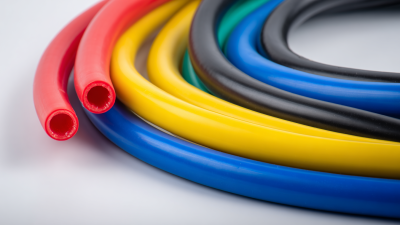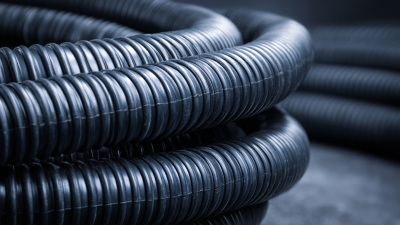As the automotive industry continues to evolve, one of the key innovations driving performance and efficiency is the development of auto silicone hoses. Unlike traditional rubber options, auto silicone hoses offer enhanced durability, temperature resistance, and flexibility, making them a preferred choice for modern vehicles. In this blog, we will explore how advancements in auto silicone hose technology are not only improving vehicle performance but also contributing to overall sustainability in automotive design. From improved fuel efficiency to greater reliability under extreme conditions, these innovations are shaping the future of the industry. Join us as we delve into the fascinating world of auto silicone hoses and uncover the transformative potential they hold for both manufacturers and consumers alike.

The automotive industry is experiencing a significant transformation with the advent of advanced silicone hose manufacturing techniques. These innovations not only enhance the performance and durability of automotive hoses but also optimize production efficiency. Emerging trends in the auto silicone hose sector are focusing on lightweight materials and environmentally sustainable practices, which are critical in meeting the evolving demands for fuel efficiency and reduced emissions in modern vehicles.
Moreover, the integration of automation and smart manufacturing processes within the silicone hose production landscape is propelling further advancements. These technologies allow for precise material formulation and enhanced quality control, resulting in hoses that are not only more reliable but also cost-effective. As manufacturers embrace these pioneering techniques, the future of silicone hoses appears brighter than ever, promising to play a vital role in the ongoing evolution of the automotive sector.
The automotive industry is witnessing a transformation driven by advancements in material science, particularly in the development of silicone hoses. These innovations not only enhance durability but also improve performance across various vehicle applications. The shift towards high-performance silicone hoses is attributed to their ability to withstand extreme temperatures and pressures, making them ideal for modern engineering demands.

Tips for achieving optimal performance with silicone hoses include ensuring a proper fit to avoid leaks and maintaining regular inspections to check for any signs of wear or degradation. Additionally, choosing hoses that are specifically designed for your vehicle's requirements can vastly increase their lifespan and efficiency.
As material science continues to evolve, the introduction of new compounds and manufacturing techniques promises even greater resilience and adaptability in silicone hoses. Keeping abreast of these innovations can empower automotive engineers and enthusiasts alike, fostering enhanced safety and reliability on the road. Implementing these cutting-edge materials not only sets the stage for higher performance vehicles but also contributes to a more sustainable automotive future.
 Silicone hoses are revolutionizing the automotive industry by significantly enhancing vehicle performance and efficiency. With a temperature range spanning from -50°C to 200°C, silicone hoses outperform traditional rubber hoses, offering greater durability and resistance to wear and tear. According to a recent report by MarketsandMarkets, the global silicone market in the automotive sector is projected to reach approximately $4 billion by 2026, driven by the increasing demand for high-performance components that contribute to sustainability and fuel efficiency.
Silicone hoses are revolutionizing the automotive industry by significantly enhancing vehicle performance and efficiency. With a temperature range spanning from -50°C to 200°C, silicone hoses outperform traditional rubber hoses, offering greater durability and resistance to wear and tear. According to a recent report by MarketsandMarkets, the global silicone market in the automotive sector is projected to reach approximately $4 billion by 2026, driven by the increasing demand for high-performance components that contribute to sustainability and fuel efficiency.
One key advantage of silicone hoses is their lightweight nature, which reduces overall vehicle weight and enhances fuel economy. A study from the Society of Automotive Engineers indicates that every 10% weight reduction in a vehicle can lead to a 5-7% increase in fuel efficiency. This is particularly crucial as automotive manufacturers strive to meet stringent emission regulations and consumer demand for greener vehicles.
Tips: When considering upgrading to silicone hoses, ensure compatibility with your vehicle’s systems to maximize performance. Additionally, regular inspections can help identify any wear or damage early, ensuring that you maintain optimal performance levels.
In recent years, the automotive industry has witnessed a significant shift towards sustainability, influencing all aspects of production, including components like auto silicone hoses. Traditionally, the manufacturing of silicone products has raised environmental concerns due to the energy-intensive processes and the use of non-renewable resources. However, innovative approaches have emerged, focusing on recyclable materials and eco-friendly production methods. By adopting practices such as energy-efficient manufacturing and utilizing renewable energy sources, manufacturers can reduce their carbon footprint while maintaining high standards of quality.
Additionally, the emphasis on sustainability has led to the development of biodegradable silicone hoses, which decompose more easily than their conventional counterparts. This shift not only addresses environmental challenges but also aligns with the increasing consumer demand for greener auto components. As automotive companies integrate sustainable practices into their supply chains, the push for eco-friendly materials becomes essential in promoting a circular economy within the industry. Through these innovations, auto silicone hoses are not only enhancing vehicle performance but also contributing to a more sustainable future in automotive manufacturing.
The automotive industry is undergoing a significant transformation, with technology integration revolutionizing the design and functionality of silicone hoses. Silicone hoses, known for their durability and resistance to extreme temperatures, are increasingly benefiting from advanced manufacturing techniques such as 3D printing and automated production lines. These innovations allow for precise customization, resulting in hoses that can be tailored to meet specific requirements for pressure, flexibility, and heat resistance, enhancing overall vehicle performance.
Moreover, the incorporation of smart technologies into silicone hose design is opening new avenues for functionality. Sensors embedded within silicone hoses can monitor temperature, pressure, and fluid flow in real time. This data-driven approach enables proactive maintenance and improves vehicle safety, as potential issues can be identified before they lead to significant failures. As the automotive sector continues to embrace electrification and hybrid technologies, these intelligent silicone hoses are set to play a crucial role in meeting the demands of modern engines, ensuring efficiency and reliability in a rapidly evolving marketplace.






